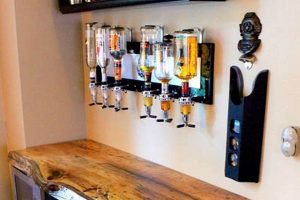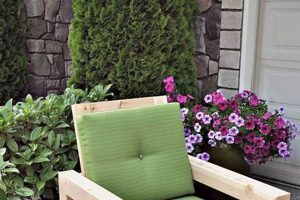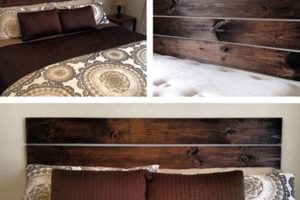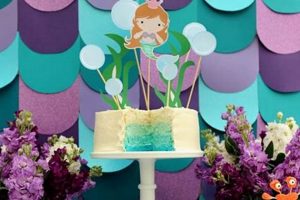The construction of custom aquatic habitats, often involving repurposed or unconventional materials, allows enthusiasts to create personalized environments for their aquatic pets. These projects range from simple conversions of glass containers to complex, multi-faceted ecosystems designed to mimic natural environments. An example involves transforming a reclaimed dresser into a stand for a large tank, integrating the existing structure for aesthetic appeal and functional support.
Creating these customized environments fosters creativity, reduces reliance on commercially produced aquariums, and potentially lowers the overall cost of fishkeeping. Historically, hobbyists have adapted materials readily available to them, leading to innovative solutions and a deeper understanding of aquatic ecosystem management. This approach allows for size and shape customization not typically available in standard retail options, ensuring an optimal fit within a specific space and aesthetic.
The subsequent discussion will delve into essential considerations for successful construction, including material selection, structural integrity assessments, water quality management, and filtration system integration. Furthermore, ethical and responsible practices regarding the health and well-being of the aquatic inhabitants will be examined in detail.
Construction Guidance for Custom Aquatic Habitats
The following outlines essential considerations for the creation of customized aquatic environments, emphasizing structural integrity, environmental control, and the well-being of aquatic life.
Tip 1: Material Selection: Prioritize inert materials to prevent water contamination. Glass and aquarium-safe silicone are frequently employed. Avoid metals susceptible to corrosion and untreated wood, which can leach harmful substances into the water.
Tip 2: Structural Integrity Assessment: Calculate water volume and weight to ensure the chosen construction method can withstand the hydrostatic pressure. Implement reinforcement strategies for larger tanks, such as bracing or thicker glass panels, to prevent catastrophic failure.
Tip 3: Filtration System Integration: Design the aquatic habitat with adequate space for filtration equipment. Consider under-gravel filters, canister filters, or sumps, depending on the bioload and desired water quality parameters. Ensure sufficient water circulation to facilitate effective filtration.
Tip 4: Water Quality Management: Establish a cycling process to cultivate beneficial bacteria that convert harmful ammonia and nitrites into less toxic nitrates. Regularly monitor water parameters, including pH, ammonia, nitrite, and nitrate levels, using appropriate test kits. Implement water changes to maintain optimal conditions.
Tip 5: Temperature Regulation: Employ a submersible heater with a thermostat to maintain a stable water temperature within the species-specific range. In warmer climates, consider a water chiller or fans to prevent overheating.
Tip 6: Lighting Considerations: Select lighting appropriate for the inhabitants and any live plants. LED lighting offers energy efficiency and customizable spectrums. Provide a consistent photoperiod to regulate biological rhythms.
Tip 7: Substrate Selection: Choose a substrate compatible with the planned inhabitants and plants. Gravel, sand, or specialized aquatic substrates offer varying benefits for root development, biological filtration, and aesthetic appeal. Thoroughly rinse the substrate before introduction to the aquatic habitat.
These considerations ensure the creation of a safe, stable, and aesthetically pleasing environment for aquatic life, fostering a balanced ecosystem and long-term success.
The subsequent section addresses advanced techniques and safety precautions, providing a comprehensive guide to responsible aquatic habitat construction.
1. Material Compatibility
Material compatibility is paramount in the context of constructing custom aquatic environments. The selection of appropriate materials directly impacts water quality, the health of aquatic inhabitants, and the long-term structural integrity of the enclosure. Incompatible materials can leach harmful chemicals, corrode, or degrade, leading to ecosystem imbalance or catastrophic failure.
- Inertness and Toxicity
Materials used in constructing the tank or its components must be chemically inert to prevent the release of toxins into the aquatic environment. For instance, certain plastics and paints contain additives that can leach into the water, harming or killing aquatic life. Aquarium-safe silicone is a common example of an inert material specifically formulated for this purpose, while untreated metals or lead-based paints are examples of incompatible and dangerous choices.
- Corrosion Resistance
Any metal components used, such as fasteners or support structures, should exhibit high corrosion resistance. Exposure to water, particularly saltwater, can cause rapid corrosion of unsuitable metals, leading to structural weakness and the release of metal ions into the water. Stainless steel, specifically grades designed for marine applications, is often utilized for its superior corrosion resistance, contrasting with carbon steel which rusts quickly in aquatic environments.
- pH Stability
Certain materials can alter the pH of the water, disrupting the delicate balance required for aquatic life. Limestone, for example, can raise the pH, making it unsuitable for fish species that require acidic conditions. Similarly, certain woods can leach tannins, lowering the pH. Selecting materials that maintain a stable pH is crucial for creating a healthy and stable aquatic environment.
- Material Degradation
The chosen materials must withstand prolonged exposure to water without significant degradation. Some plastics can become brittle and crack over time, while untreated wood can rot and decompose. Glass and acrylic are commonly used for tank construction due to their durability and resistance to degradation in aquatic environments. Regular inspection is required to identify any form of material degradation, and repairs or replacement must be considered.
The careful selection of compatible materials is a foundational aspect of successful custom aquatic habitat construction. By prioritizing inertness, corrosion resistance, pH stability, and material durability, hobbyists can create safe and sustainable environments for their aquatic pets, reducing the risk of water contamination, structural failure, and harm to the inhabitants.
2. Filtration Efficiency
Effective filtration is a critical aspect of maintaining a healthy and stable aquatic ecosystem within custom-built habitats. The design and implementation of a
filtration system directly influence water quality, waste removal, and overall biological balance, impacting the well-being of aquatic organisms. The selection of an appropriate filtration method is paramount for successful custom aquatic habitat construction.
- Mechanical Filtration
Mechanical filtration involves the removal of particulate matter from the water column. Sponges, filter floss, and gravel beds serve as physical barriers, trapping debris such as uneaten food, plant matter, and detritus. In a custom-built system, pre-filtration chambers can be incorporated to house these mechanical filters, preventing large particles from clogging biological filtration components. The efficiency of mechanical filtration directly affects water clarity and reduces the bioload on subsequent filtration stages.
- Chemical Filtration
Chemical filtration utilizes various media to remove dissolved organic compounds, pollutants, and unwanted chemicals from the water. Activated carbon, resins, and zeolite are commonly employed to adsorb or absorb these substances. In custom aquatic habitats, chemical filtration can be tailored to address specific water quality issues, such as excessive ammonia or phosphate levels. The strategic placement of chemical filtration media within the system enhances its effectiveness in maintaining optimal water parameters.
- Biological Filtration
Biological filtration relies on beneficial bacteria to convert harmful nitrogenous waste products, such as ammonia and nitrite, into less toxic nitrates. These bacteria colonize surfaces within the aquarium, including substrate, filter media, and decorations. Custom systems often incorporate a sump or refugium, providing a dedicated space for biological filtration and increasing the overall surface area available for bacterial colonization. An effective biological filter is essential for establishing a stable nitrogen cycle and maintaining water quality.
- Water Circulation and Flow Rate
Adequate water circulation is critical for maximizing filtration efficiency. Water flow carries waste products to the filter, distributes nutrients, and prevents the formation of stagnant areas. In custom-built systems, pump selection and plumbing design play a crucial role in achieving optimal water circulation. An appropriate flow rate ensures that the entire water volume passes through the filtration system multiple times per hour, promoting thorough waste removal and nutrient distribution. Improper circulation can lead to dead spots, anaerobic conditions, and reduced filtration efficiency.
The integration of effective mechanical, chemical, and biological filtration, coupled with strategic water circulation, is essential for sustaining a healthy aquatic environment within custom-designed habitats. By carefully considering these aspects, aquarists can create stable and aesthetically pleasing aquatic ecosystems tailored to the specific needs of their chosen inhabitants.
3. Structural Soundness
Structural soundness is a non-negotiable aspect of creating aquatic habitats, particularly in the context of self-assembled or repurposed tank projects. The ability of the enclosure to withstand hydrostatic pressure, resist material degradation, and maintain its integrity over prolonged periods determines the success or catastrophic failure of the endeavor. A lack of attention to structural details can result in significant water damage, loss of aquatic life, and potential injury.
- Material Load-Bearing Capacity
The selected materials must possess the requisite strength to support the immense weight of water. For example, glass or acrylic panels must be of sufficient thickness based on tank dimensions to prevent bowing or cracking under pressure. A failure to accurately calculate the necessary thickness or substituting with lower-grade materials compromises the entire structure, as illustrated by DIY projects where thinner glass succumbs to pressure, resulting in a complete structural breach. Using reinforced polymers for bracing, or adhering to established engineering guidelines, is crucial for ensuring material adequacy.
- Joint Integrity and Sealing
The joints between the tank’s components represent points of vulnerability. The adhesive or sealant used to bond these surfaces must form a waterproof and mechanically strong bond. Aquarium-grade silicone is frequently employed, but its application requires meticulous preparation and execution. Insufficient surface preparation, improper curing times, or the use of non-aquarium-safe sealants can lead to slow leaks or sudden joint failures, exemplified by tanks where poorly applied silicone gives way, resulting in a gradual or rapid loss of water. Proper clamping during the curing process and rigorous leak testing are essential to verifying joint integrity.
- Base Support and Leveling
The base or stand supporting the tank must provide uniform weight distribution and absolute levelness. Uneven weight distribution creates stress points on the tank, increasing the risk of cracking or joint failure. A warped or unstable stand can introduce torsional forces, further compromising the structure. For example, placing a tank on a stand that is not perfectly level can lead to uneven pressure distribution, potentially causing the glass to crack over time. The use of shims to correct minor imperfections and robustly constructed stands that exceed the tank’s filled weight are necessary measures.
- Long-Term Material Degradation Resistance
Materials, particularly those in constant contact with water, are subject to degradation over time. Wood can rot, metals can corrode, and some plastics can become brittle. Selecting materials resistant to water damage and incorporating protective coatings or barriers extends the lifespan of the tank. For instance, using untreated wood will eventually cause the wood to rot due to exposure to water, therefore this material is deemed unsuitable. Regular inspection for signs of degradation and timely repairs prevent minor issues from escalating into critical structural weaknesses. Regular maintenance will ensure that problems are addressed before significant structural integrity becomes a hazard.
A comprehensive understanding of material properties, joint mechanics, and support systems is paramount for anyone undertaking self-assembled aquarium construction. A disregard for these structural considerations not only jeopardizes the investment in materials and aquatic life but also poses a significant safety risk. Adhering to established engineering principles and prioritizing robust construction techniques is the key to a safe and enduring aquatic display.
4. Water Quality
Water quality constitutes a critical determinant of success in the establishment and maintenance of any aquatic ecosystem, particularly within self-constructed aquatic habitats. Deviation from optimal water parameters precipitates physiological stress, disease susceptibility, and mortality among aquatic organisms. Therefore, conscientious monitoring and management of water quality are essential for responsible aquatic husbandry.
- Ammonia and Nitrite Control
Ammonia and nitrite represent highly toxic nitrogenous waste products generated by aquatic organisms and the decomposition of
organic matter. In a newly established tank, a biological filter consisting of nitrifying bacteria must be cultivated to convert these substances into less harmful nitrates. Insufficient biological filtration or overstocking can lead to elevated ammonia and nitrite levels, causing severe stress or death to aquatic life. Regular water testing and adherence to recommended stocking densities are critical for preventing ammonia and nitrite accumulation. The selection of appropriate filter media and the establishment of a stable bacterial colony are fundamental to maintaining water quality in DIY fish tanks. - Nitrate Management
While less toxic than ammonia and nitrite, elevated nitrate levels can still negatively impact aquatic organisms over time. Nitrates accumulate as the end product of the nitrogen cycle and are removed through water changes or the use of specialized nitrate-removing media. Infrequent water changes or overfeeding can result in high nitrate concentrations, promoting algae growth and stressing fish. Regular partial water changes, typically 25-50% of the tank volume, are essential for diluting nitrate levels and maintaining water quality in DIY setups. The integration of live plants can further aid in nitrate reduction, providing a natural means of nutrient removal.
- pH Stability
pH, a measure of acidity or alkalinity, significantly influences the physiological processes of aquatic organisms. Each species has a specific pH range in which it thrives. Fluctuations outside this range can cause stress, impede growth, and impair reproductive capabilities. The pH of aquarium water is influenced by factors such as substrate composition, buffering capacity, and the presence of dissolved substances. Selecting appropriate substrate materials, such as inert gravel or buffering substrates, and monitoring pH regularly are essential for maintaining stable water chemistry. Periodic testing and adjustment, using aquarium-safe chemicals when necessary, contribute to a stable and healthy aquatic environment in DIY fish tanks.
- Water Hardness
Water hardness, a measure of dissolved minerals such as calcium and magnesium, also affects the suitability of water for different aquatic species. Soft water is characterized by low mineral content, while hard water contains higher concentrations of minerals. Certain fish species thrive in soft water, while others prefer hard water conditions. Selecting appropriate substrate materials and decorations that do not significantly alter water hardness is important. Testing water hardness and adjusting it using commercially available products allows aquarists to tailor the water chemistry to the specific needs of their chosen inhabitants within their custom-built aquariums. The source of water used to fill the tank also has a significant impact; tap water may require pre-treatment to reduce chloramine or chlorine levels.
These facets of water quality management are critical considerations for anyone constructing a custom aquatic habitat. Prioritizing water quality ensures the health and longevity of aquatic inhabitants, contributing to the success and sustainability of these projects. Neglecting these aspects can lead to ecosystem instability, disease outbreaks, and ultimately, the failure of the DIY aquatic endeavor. Therefore, integrating robust water quality management strategies is paramount for responsible and rewarding fishkeeping.
5. Aesthetic Integration
Aesthetic integration represents a fundamental consideration within the realm of custom aquatic habitat construction. The visual harmony between the aquatic environment and its surrounding space elevates a functional enclosure to an intentional design element. The cause-and-effect relationship is direct: a well-integrated tank enhances the overall ambiance, while a poorly designed one detracts from it. Its importance stems from the capacity to transform a practical necessity into an artistic expression, seamlessly blending the natural world with human-designed interiors. A basic example consists of concealing filtration equipment within the aquarium stand, ensuring mechanical components do not detract from the visual appeal of the aquatic display. Neglecting this aspect can result in a visually discordant element within a room.
Further applications of aesthetic integration extend beyond mere concealment. The selection of substrate, hardscape (rocks, driftwood), and plant life should align with the desired aesthetic theme. For instance, a minimalist design might incorporate a single, striking piece of driftwood and a sparse planting arrangement. Conversely, a biotope aquarium aims to replicate a specific natural habitat, requiring careful consideration of the geographical origin of each element. Practical application involves careful planning of the aquarium’s external design to correspond with the room’s existing dcor, perhaps mirroring color palettes or architectural styles. Integrating custom lighting solutions can also enhance the aquarium’s visual impact, highlighting particular features and creating a captivating focal point. This allows the owner to tailor the aquariums appearance and minimize the aesthetic impact of the supporting components, such as wiring and plumbing.
In summary, aesthetic integration is a core principle of aquatic habitat construction, transforming a functional necessity into a visually engaging element within the living space. Challenges can arise from balancing aesthetic goals with the practical needs of the aquatic inhabitants and the aquarium’s maintenance requirements. Ultimately, successful integration demands careful planning, thoughtful material selection, and an awareness of both the natural and artificial environments involved. By prioritizing aesthetics, custom aquatic habitats elevate the practice of fishkeeping from a simple hobby to an element of design.
Frequently Asked Questions Regarding Custom Aquatic Habitat Construction
The subsequent questions address common concerns and misconceptions surrounding the creation of custom aquatic habitats, providing clarity on critical aspects of design, construction, and maintenance.
Question 1: What are the primary safety considerations when constructing a custom fish tank?
The primary safety considerations involve structural integrity and material compatibility. The tank must withstand hydrostatic pressure without catastrophic failure, and materials must be non-toxic to aquatic life and resistant to degradation in aquatic environments. Ensuring proper weight distribution and stable support are equally important safety measures.
Question 2: What materials are deemed unsuitable for use in homemade aquarium construction?
Materials such as untreated wood, certain plastics not rated for aquatic use, lead-based paints, and metals prone to corrosion are unsuitable for custom aquarium construction. These materials can leach harmful chemicals into the water, compromise structural integrity, or alter water chemistry to the detriment of aquatic inhabitants.
Question 3: How is proper sealing achieved to prevent leaks in a custom-built aquarium?
Proper sealing requires meticulous surface preparation, the application of aquarium-safe silicone sealant, and adequate curing time. Surfaces must be clean and dry prior to sealant application. Sufficient clamping during the curing process ensures a strong and watertight bond. Leak testing should be conducted before introducing any substrate or water.
Question 4: What are the essential components of an effective filtration system in a
DIY aquatic environment?
An effective filtration system comprises mechanical, chemical, and biological filtration components. Mechanical filtration removes particulate matter, chemical filtration eliminates dissolved pollutants, and biological filtration converts harmful nitrogenous waste into less toxic substances. Sufficient water circulation is also critical for optimizing filtration efficiency.
Question 5: How does one ensure adequate water quality in a self-constructed aquarium?
Maintaining water quality necessitates regular monitoring of ammonia, nitrite, nitrate, pH, and water hardness levels. Consistent partial water changes, proper substrate selection, and the establishment of a stable biological filter contribute to optimal water quality. Overstocking and overfeeding must be avoided.
Question 6: What is the recommended thickness of glass for a given aquarium size to ensure structural integrity?
The recommended glass thickness is dependent on the dimensions of the tank. As a general guideline, larger tanks require thicker glass to withstand hydrostatic pressure. Consult established engineering formulas or reputable aquarium construction resources to determine the appropriate glass thickness for a specific tank size. Erring on the side of caution and using thicker glass is advisable for added safety.
The above addresses prevailing concerns, emphasizing safety, material selection, sealing techniques, filtration strategies, and water quality preservation critical for successfully building custom aquariums.
The subsequent section explores advanced techniques and emerging technologies within the field of aquatic habitat construction.
Conclusion
The preceding discussion elucidated crucial facets involved in creating custom aquatic habitats. Consideration of material compatibility, filtration efficiency, structural soundness, water quality management, and aesthetic integration constitutes the foundation for successful, responsible implementation of diy fish tank ideas. Ignoring these principles risks ecosystem instability, structural failure, and potential harm to aquatic life.
The construction of these custom environments demands careful deliberation and adherence to established practices. The ultimate success of diy fish tank ideas rests on prioritizing the health and well-being of aquatic inhabitants, promoting sustainable practices, and fostering a deeper understanding of aquatic ecosystem dynamics. Further investigation and refinement of these techniques will improve aquatic habitat construction, benefiting both the environment and the hobbyist.







